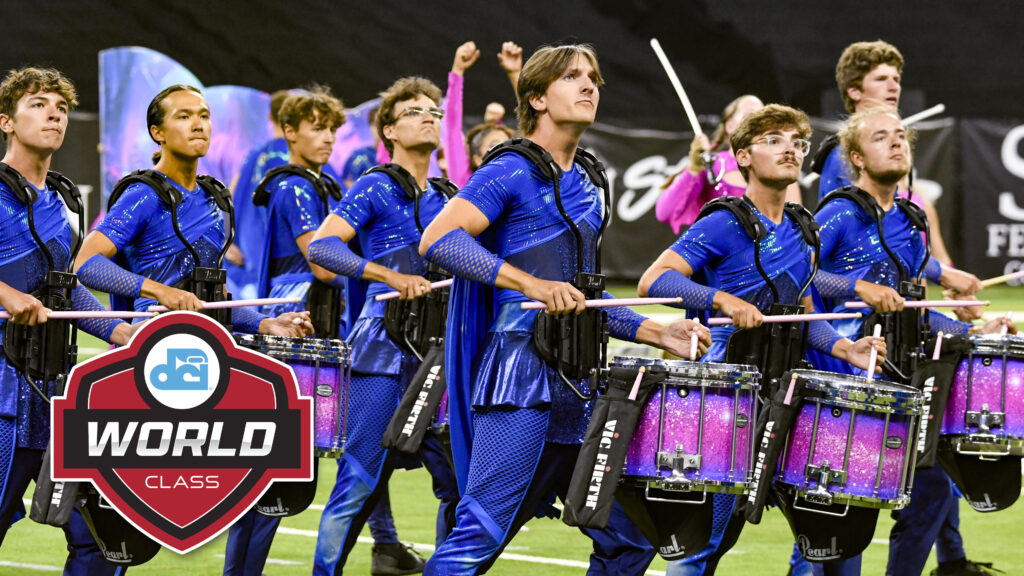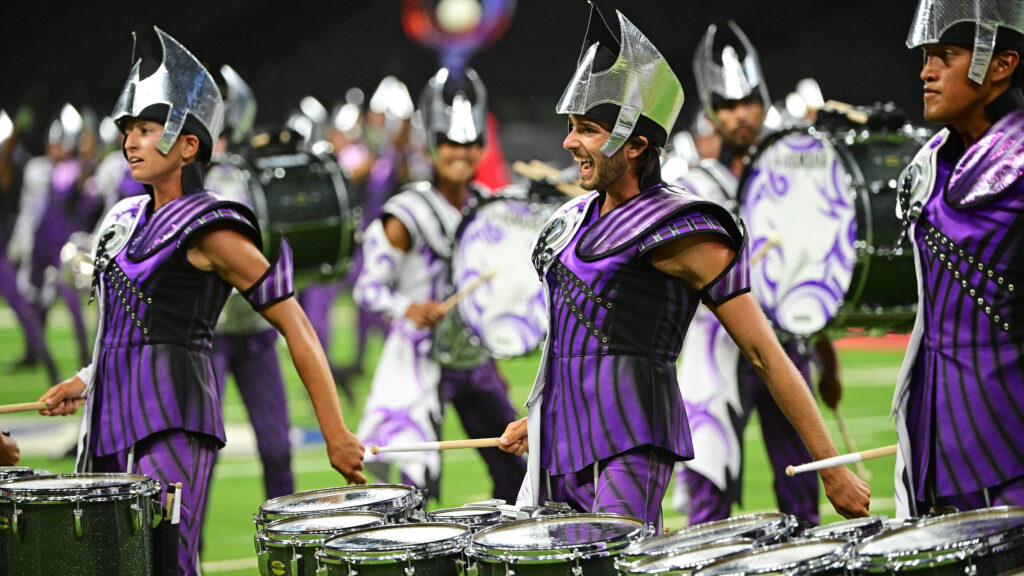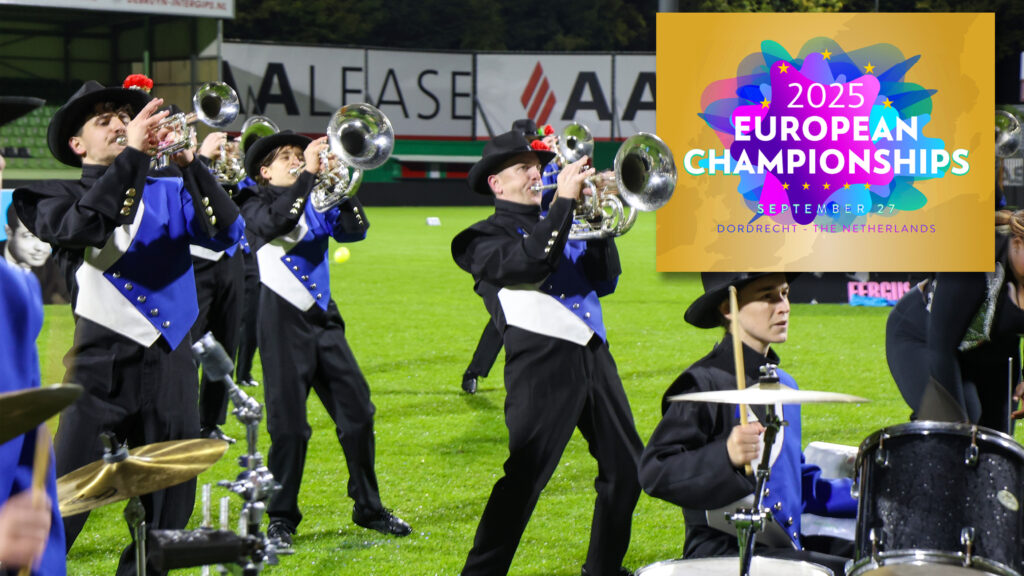
1975 27th Lancers
Drum Corps International was just in its third season in 1974, when Madison Scouts made a big lunge for the World Championship title at Cornell University’s Schoellkopf Stadium in Ithaca, N.Y. That year, four corps made the Finals for the first time: DeLaSalle Oaklands (which would become Oakland Crusaders the following year), Purple Lancers (in their last season), Blue Devils and Phantom Regiment (each being finalists ever since). 1974 was a tough one for corps that had been World Championship finalists in DCI’s first two seasons: Blue Stars, after placing 2nd and 3rd at the first two DCI World Championships, slipped to 12th. But four other corps fared even worse: Black Knights fell from 10th in 1973 to 15th. 27th Lancers had an off year and slipped from 7th in 1973 to 20th, (rebounding the next year to 4th). Bridgemen (still known as St. Andrew’s Bridgemen), fell to 26th after placing 11th and 9th in DCI’s first two seasons. Argonne Rebels, 5th and 11th the previous two seasons, slipped to 33rd and never did recover. Although 4th in 1973, Madison Scouts placed 14th at the first DCI World Championship in Whitewater, WI in 1972. The combination of future DCI Hall of Famers Ray Baumgardt writing the brass arrangements and brass staff member Jimmy Elvord instilling a power into the horn line’s performance made the line the envy of the activity. Projected by many to win it all in 1974, the corps won the DCI World Championship Prelims by 0.90 over the Kingsmen and 1.15 over Santa Clara Vanguard, but lost to SCV in the Finals by 0.65. At a post-season show in Syracuse, N.Y. the day after the World Championship Finals, Scouts beat Santa Clara Vanguard, the winner the night before, by 1.40, with the fourth-place Muchachos slipping in between those two corps in second. We are quite fortunate to have any visual recordings from DCI’s third season. At the time, it was still considered somewhat of a stretch that anyone would have an interest in watching old drum corps shows in the future. The first two DCI World Championships in Whitewater were not professionally recorded. In 1974, a local upstate New York PBS station recorded the DCI World Championship Prelims on videotape for its own news segment to promote the Finals; then used all but one of the cartridges to record over for its news broadcast. An employee of the station had the idea that someone might be interested in seeing some of the performances some day, and “borrowed” the remaining cartridge, preserving the World Championship performances of the Scouts, Santa Clara Vanguard and Anaheim Kingsmen.
The 1975 Drum Corps International World Championships was the first of two consecutive years that DCI went to Philadelphia, “The Birthplace of America,” for the country’s yearlong bicentennial celebration. Events were held at the University of Pennsylvania’s Franklin Field, and viewers across the United States witnessed the entire Finals competition broadcast live on PBS for the first time. The 27th Lancers’ 4th-place finish in 1975 was a comeback, being that the corps plummeted to 20th place in 1974 after finishing 4th in 1972 and 7th in 1973. The corps received a lot of good publicity for performing on the nationally syndicated “Mike Douglas Show” that year. 27th’s performance originated from the street outside the show’s studio in Philadelphia on the same day that famed musical comedian Victor Borge was a guest. Borge was dressed up in a marching uniform and bore a mace as he led the corps down the street, and no one in the audience knew it until Douglas interviewed him as drum major. 27th Lancers’ 1975 production created quite a bit of talk among drum corps fans for its uniqueness and innovations. DCI Hall of Fame visual designer Ralph Pace started the corps in the upper left corner of the field, at a time when drills were still purely symmetrical. He played with symmetry by making much of the drill balanced, but not on the 50-yard line that was the custom, earning the corps a 10.0 in Marching and Maneuvering General Effect. . Another visual element that wasn’t exploited before this production was the frequent use of changing horn positions to different parts of the field and the stands for visual and dynamic impact. As the head percussion instructor, DCI Hall of Famer Joe Marrella had to recruit five of the seven snare drummers since February of that year, and still pulled off a 9.7 in Drum General Effect at the World Championships. Unique among instruments in his section was the chime “cage” that allowed for getting around the provision that the only mallet instruments allowed on the field were bells and xylophone. One of the allowed two percussion instruments was essentially a rack of eight chimes (allowed as “accessories”) upon a rack of bongos. Read more about the 27th Lancers chime cage.
The corps performed its opener of “Crown Imperial” each of the prior two years. William Walton wrote the march for the planned 1937 coronation of Britain’s King Edward VIII, but when Edward abdicated to marry a twice-divorced American socialite, the piece was premiered on the originally scheduled day for Edward’s brother, King George VI. The upper left corner entrance with its high-legged goose step toward the stands generated a huge audience reaction. The jazz tune “Chameleon” was written by jazz-funk pianist and bandleader Herbie Hancock (and other contributors) for Hancock’s 1973 “Head Hunters” album. It quickly became one of the best-known jazz standards for its repetitive funky bass line and was recorded by many jazz artists, including Maynard Ferguson on his 1974 album, also titled, “Chameleon,” which was the version played by the corps.

1975 27th Lancers
The concert standstill production of “Celebrate” was a pop hit from “Suitable for Framing,” a 1969 album by the pop-rock band, Three Dog Night. Written by Gary Bonner and Alan Gordon, it was best known for its repetitive chorus, “Celebrate, celebrate, dance to the music.” This is when “double flags”—a single pole with a flag attached on either end—were introduced to drum corps. They were said to be the idea of Marie Gambale, who taught one of the winter color guards of St. Anthony’s, also from the corps’ hometown of Revere, Mass. Guard instructor Steven Covitz ran with the idea, a few years before he became a drill writer. While only the front 10 flags were of the double variety, this was something that was of extreme notice. “Spectrum Novum” made full use of the chimes that were so visually prevalent on the field. The melody was based on the hymn tune, “St. Theodulph,” best known in many religious denominations as “All Glory, Laud and Honor,” composed by W.H. Monk and Melchoir Teschner in 1615. According to brass arranger James Wedge, drill designer Ralph Pace brought in the music score of, “Fanfare Prelude: Oh How Shall I Receive Thee,” by J. Robert Hanson. A high school band he was teaching in Philadelphia was playing it and the corps just changed the name, though Wedge doesn’t recall how they came up with the name, “Spectrum Novum.” Wedge states the horn members found the piece rather stressful to play because he wrote it in four flats, a key unheard of in the age of G bugles. He had the tuning slides lengthened on the horns to get notes normally unplayable on the G-keyed bugles. “Danny Boy,” performed by the corps over many years, wasn’t the first song to be set to the tune of “Londonderry Air,” but it is certainly the most famous. It was collected and first published by the Society for the Preservation and Publication of the Melodies of Ireland in the 1855 book “The Ancient Music of Ireland.” The huge rotating wheel of drums, horns and color guard, was one of the most memorable sights of the year. The closing guard routine, having the line of rifles pour through the sudden opening in the drums and amidst the swirling of the double flags, was as effective as it was simple, and it put a solid exclamation mark on the corps’ summer season.
For this week only, you can save on the Legacy Collection DVD that contains this complete 27th Lancers performance, along with all finalists from the 1975 DCI World Championships. Buy the 1975 Legacy Collection DVD. (Available this week only for 20% off. Regular price: $35.95.)
1975 Overview
Discount DVD offer ends Monday, April 1 at 8:30 a.m. ET.

Michael Boo was a member of the Cavaliers from 1975-1977. He has written about the drum corps activity for more than a quarter century and serves as a staff writer for various Drum Corps International projects. Boo has written for numerous other publications and has published an honors-winning book on the history of figure skating. As an accomplished composer, Boo holds a bachelor's degree in music education and a master's degree in music theory and composition. He resides in Chesterton, Ind.





